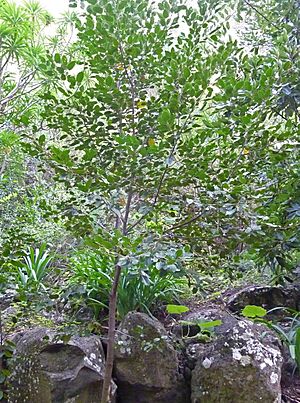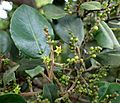Rhamnus glandulosa facts for kids
Quick facts for kids Rhamnus glandulosa |
|
|---|---|
 |
|
| Conservation status | |
| Scientific classification | |
| Genus: |
Rhamnus
|
| Species: |
glandulosa
|
| Synonyms | |
|
|
The Madeira Buckthorn (Rhamnus glandulosa) is a special kind of plant that belongs to the Rhamnaceae family, also known as the buckthorn family. This tree is endemic, which means it grows naturally only in a few specific places: the islands of Madeira and the Canary Islands.
Contents
What Does the Madeira Buckthorn Look Like?
The Madeira Buckthorn is usually a small tree. It often grows to be about 5 to 8 meters (16 to 26 feet) tall. In very good conditions, especially in a healthy Laurisilva forest, it can even reach up to 10 meters (about 33 feet) high!
This tree has a gray trunk. Its leaves are tough and feel a bit like leather. They stay green all year round, so the tree is an evergreen. If you look closely, you might see tiny bumps, called glands, where the leaf veins meet.
The flowers of the Madeira Buckthorn are a yellow-green color and grow in small groups. After the flowers, the tree produces round fruits called drupes. When these fruits are ripe, they turn a dark purple-black color.
Where Does the Madeira Buckthorn Grow?
The Madeira Buckthorn is only found on the islands of Madeira and the Canary Islands. It loves to grow in a special type of forest called the laurel forest.
On Madeira, you can find this tree at middle to high elevations, often near rivers. In the Canary Islands, it is mostly found in the laurel forests. It's not a very common tree. On the Canaries, it's listed as a Vulnerable plant. This means it needs protection because its numbers are decreasing. It grows on the islands of Tenerife, La Palma, La Gomera, and Gran Canaria, but it is most commonly seen on Tenerife.
In Madeira, the Madeira Buckthorn faces some threats. Things like invasive species (plants or animals that are not native and can harm the local environment) and changes in how often forest fires happen can put this tree at risk. Stronger fires are also a problem for its survival.
Images for kids
See also
In Spanish: Rhamnus glandulosa para niños





